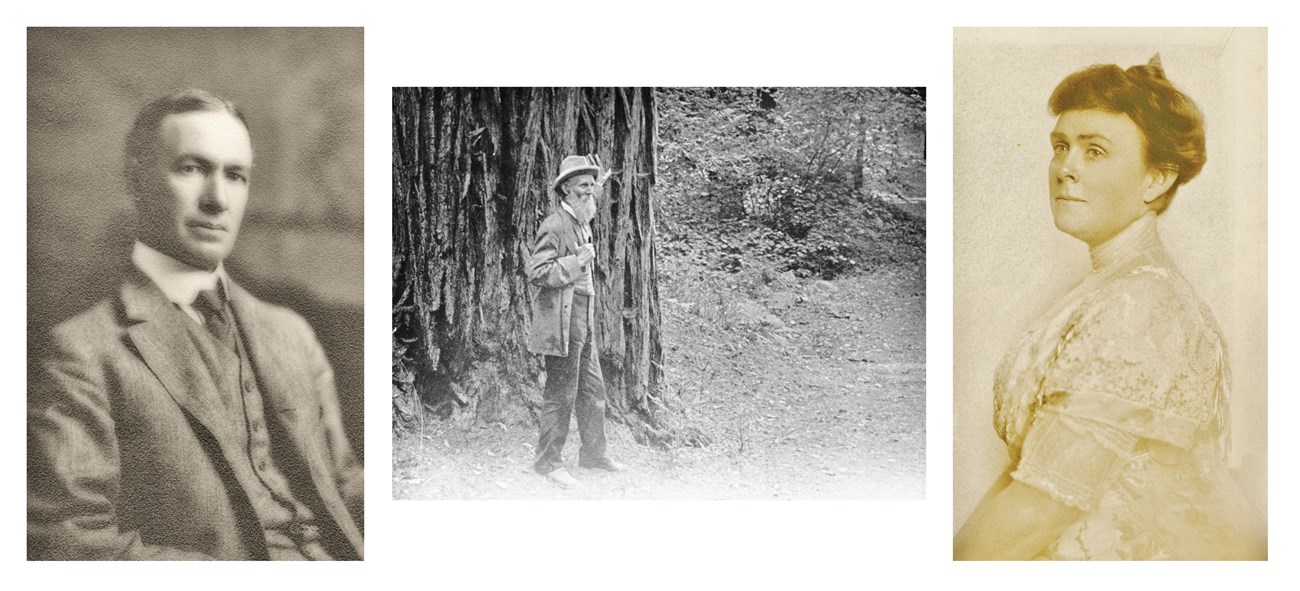For the TreesA San Francisco building boom during the Gold Rush demanded an increased timber supply. California forests provided miners with convenient sources of lumber and local redwood groves were as good as gold. Commercial logging expanded into the forests of Marin County to meet the demand. As the gold towns grew the redwood trees started to disappear. Logging of the areas surrounding Muir Woods began in the mid-1800s. Easily accessible areas were logged first, but news of the large trees in isolated Redwood Canyon drew interest. By 1903, more efficient logging and transportation made harvesting timber more convenient. The Tamalpais Land and Water Company leased parcels of land for development. Redwood Canyon was the last holdout. Conservationists, avid hikers, and the Tamalpais Sportsman's Association had a strong desire to save the Redwood Canyon trees from logging. They appealed to Congressman William Kent, a member of the Sportsman's club and a conservationist, to purchase and protect Redwood Canyon. In 1905, William Kent and his wife, Elizabeth Thatcher Kent, bought the 611 acres of the canyon. The area was soon made available to the public by improving road and rail access and providing basic amenities for visitors. In 1907, designs for a new reservoir through Redwood Canyon threatened to submerge the magnificent trees. Upon learning of this proposal, Kent began his campaign to convince President Theodore Roosevelt that Redwood Canyon should be preserved and out of reach of the water company. To quickly prevent the reservoir construction from moving forward, William Kent donated 298 acres to the government. This allowed President Roosevelt to formally set aside Kent's gift as a National Monument through the Antiquities Act of 1906, thus preventing any current and future development. Kent wished to honor the legendary conservationist John Muir by renaming the area of Redwood Canyon to Muir Woods. When Roosevelt suggested changing the name of Muir Woods to reflect Kent's gift, William Kent respectfully declined insisting that his "I've good, husky boys" would be able to carry on his name, and "if these boys cannot keep the name of Kent alive, I am willing it should be forgotten." John Muir sent a letter to William Kent in response to the naming of the Muir Woods National Monument stating "This is the best tree-lover's monument that could be found in all the forests in the world. You have done me great honor and I am proud of it." 
Left:Golden Gate NRA, Park Archives, GOGA 14349. Middle and Right: Golden Gate NRA, Park Archives, GOGA 32470 Ranching in the GGNRA's Marin ParklandsAreas of the GGNRA still retain a rural ranching character that has been present in Marin County since the 1800s. Mexican land grantees brought livestock in to their ranchos to take advantage of rich grazing land found in Olema Valley and Tennessee Valley. In the mid-1800s, Portuguese and Swiss immigrants, who originally came to find California gold, turned to dairy and beef ranching. With the demand for meat, milk, and butter from a booming San Francisco, ranching in the valleys grew into a thriving local industry. The dairy cows were rounded up twice a day for milking by hand. If one animal was missing from the herd a cowboy was sent out to bring her in. On occasion a ranch hand would encounter Military Police patrolling the heavily used Army areas that bordered the ranch lands. One-time Silva Ranch cowboy, Werner Ottens, laughingly remembered being the object of target practice one night in 1948 as he was out herding the cattle. As the dairy industry evolved across the nation, the local ranching culture encountered difficulties in keeping up with the necessary improvements to their operations. Dairy buildings had to be remodeled for sanitary measures to ensure the milk produced reached the Grade A level. Although nearly every dairy in Olema Valley reached this high grade in the 1950s, the environmental laws created in the 1970s soon pushed the dairies out of business as they did not have the finances nor the space to meet the requirements. All of Olema Valley's dairy ranches were closed by 1975. Many of the lands were added to the GGNRA and the Point Reyes National Seashore with the help of the ranchers who wished to see the land remain intact and undeveloped. Today, some former dairy ranch structures have been repurposed to serve recreational functions within the GGNRA. The Miwok Stables Center located near the Tennessee Valley trailhead uses the former dairy buildings for educational programs and keeps horses in the historic stables. This partnership between the Miwok Stables and the GGNRA helps preserve this important part of Marin County history. 
Left: Golden Gate NRA, Park Archives, GOGA-2902 Right: Golden Gate NRA, Park Archives, GOGA 17928.02 |
Last updated: October 11, 2022
